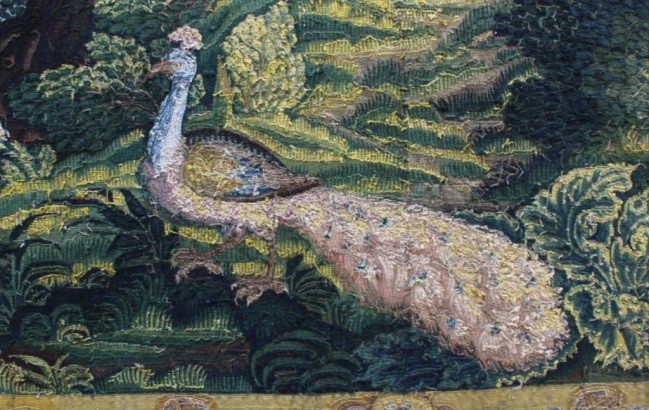July saw the tapestry team back at Doddington Hall, this time to look at the rest of the tapestries from the Holly bedroom that were taken down by Lincoln University students and wet cleaned in Belgium in 2010. We are now well over half way to completing the stitched conservation of the first two tapestries from this set here at the Heritage Skills Centre (the Cobbler and the Bagpiper and dancing dog) so we thought it was a good time to unroll the other four tapestries (which have remained at Doddington Hall) and have a good look at their condition since they were wet cleaned.
We were all very excited about this in the tapestry team as we had only seen photographs of these tapestries before they were cleaned and they have been rolled up ever since their return from Belgium back in 2010. The characters in these tapestries include a Peddler carrying his wares, a Falconer, a Courting couple with a beautiful peacock in the scene and a Hunter resting by a tree with his gun.
Image 1. Here is an image of the courting couple in their beautiful 17th Century dress.
We spent time photographing the tapestries front and back and most importantly were able to make time estimates on how long we think the stitched conservation will take for each tapestry so we can plan out the remainder of our time here at the Heritage Skills Centre.
When carrying out stitched conservation of a tapestry, due to its size it is worked in 20 cm wide sections along its length whilst on the tapestry frame (as talked about in one of our previous blogs). To help us with our estimating we therefore divided the tapestries into their 20 cm sections using a tool (provided by Elaine Owers our tapestry consultant), which comprised a long wooden pole onto which lengths of string are attached at 20 cm intervals. This was laid across each tapestry whilst they were spread flat on the floor. Photographs of each tapestry were then marked where the string lines fell across the design. This allowed us to work systematically across each tapestry, documenting and photographing each individual section, calculating how long the damage within them might take to conserve.
Image 2. Here is an image of the Hunter tapestry which has been divided up into its 20 cm sections for the estimating process.
Two of the tapestries in particular (the peddler and the Hunter) will provide us with a number of challenges as they both have been cut to fit over doors within the Holly bedroom and have therefore sustained more significant damage to these cut edges from many years of handling. A number of the sections within these two tapestries had a large number of hours allocated to them, as many as 150 hours!
Image 3. Here is an image of the Peddler tapestry. The right-hand side of this tapestry covers the door to the Holly bedroom.
Whilst looking at the tapestries we were also able to look at the underside of each tapestry and see the vibrant colours that remain where they have not been exposed to light which has faded the colours on the front.
Image 4 and 5. Here is a photograph from the front and back of the tapestry of the Peacock from the courting couple tapestry. You can see what remains of the beautiful pinks and purples at the back that have faded to greys and browns on the front of the tapestry.
We took three days to complete all of our documentation and estimating at Doddington Hall and we can now begin to plot times on our calendar to have the tapestries completed. The four tapestries have been rolled back up and now await their turn for conservation here at the Heritage Skills Centre.
For images and weekly updates on the conservation project, follow us on Instagram at conservation_at_doddington.






